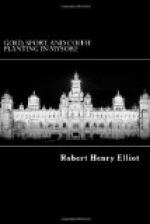The governing principle, then, as regards shade for coffee is, that you should have on the land the smallest number of boles, because the more you multiply boles the more ground you waste; and the greater the number of large trees there are, the greater, of course, will be the number of large roots in the land, and the greater demand will there be on the resources of the soil; the greater, too, will be the waste of manure put down by the planter for the benefit of his coffee; and last, but by no means least, the smaller will be the amount of leaf deposit. I have seen much shade so managed as to give the greatest amount of boles with the smallest amount, and spread of branches, whereas the object of the planter ought to be to furnish the smallest number of boles with the greatest proportionate amount and spread of branches and foliage. And this unfortunate error, the evil of which will become more and more apparent as time advances, would never have been committed, had the primary principle I have pointed out been grasped at the outset.
Let us then keep firmly in mind that, (1) we require trees that will, from their wide-spreading branches, enable us to do with the smallest number possible on the land, and that (2) if we trim up the lower branches of these trees when the trees are young because we do not like to see them too closely over the coffee, we shall entirely defeat the main object we have in view, because we shall certainly produce a tall tree with a small head, and consequently small spread of branches; and the clear apprehension of the principle first named guides us at once to the selection of the right kind of trees, and their proper treatment. I will now proceed to state the names of the trees that are, in my experience, the most desirable, and, secondly, those which are good for coffee, but which for various reasons are undesirable. After much and close study of this important subject, and a very long experience, I have come to the conclusion that the only trees which are at once easily propagated; free from the risks of attacks from cattle owing to their being grown from long cuttings; little liable to attacks from parasites, and which afford a proper degree of shade, and also admit the largest relative supply of light; which afford a large supply of leaf deposit; and which lastly, but by no means leastly, have very wide spreading branches, are only five in number. I give first the Kanarese and then the botanical name of each. There are, then, Cub Busree (Ficus tuberculata), the Gonee (Ficus Mysorensis), the Kurry Busree (Ficus infectoria), Eelee Busree (a variety of the last named), and Mitlee.[52]




